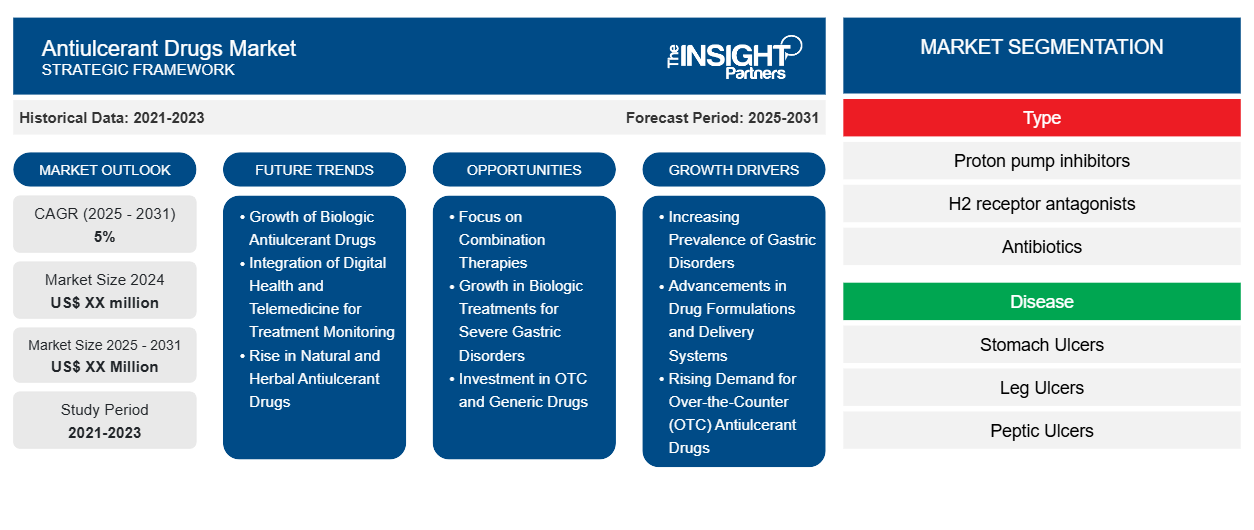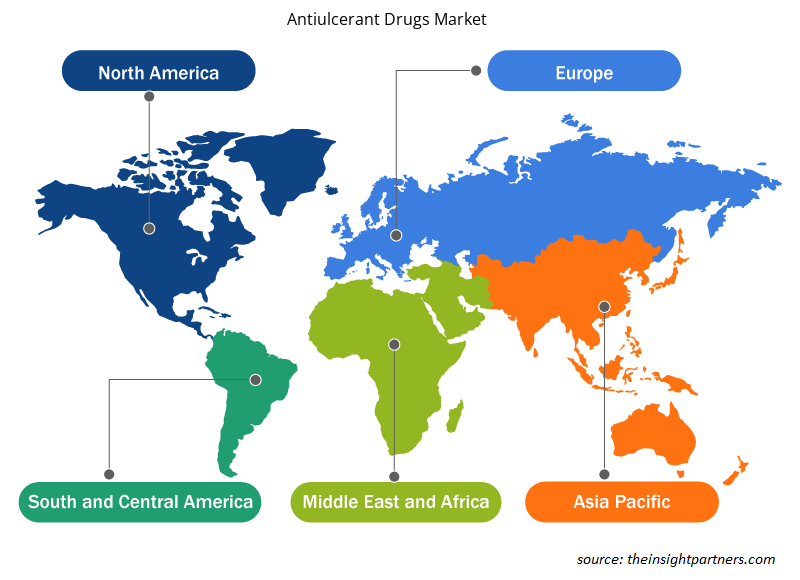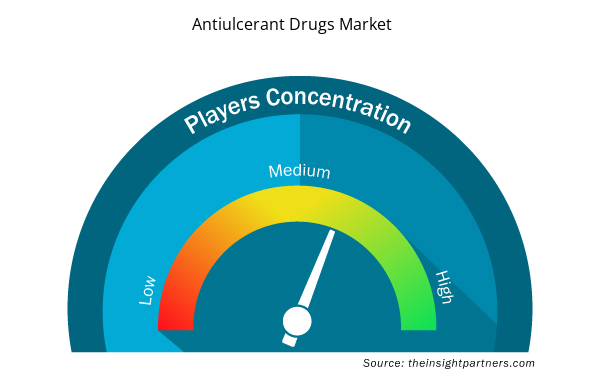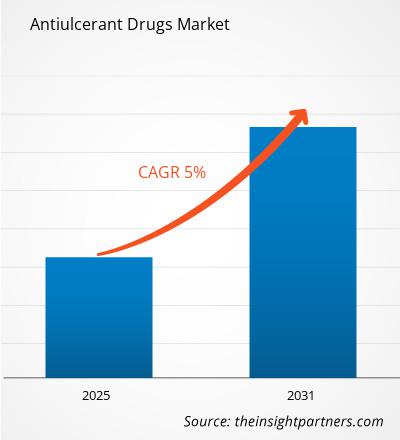The Antiulcerant Drugs Market is expected to register a CAGR of 5% from 2025 to 2031, with a market size expanding from US$ XX million in 2024 to US$ XX Million by 2031.
The report is segmented by Type (Proton pump inhibitors, H2 receptor antagonists, Antibiotics, Gastric mucosal protective drugs, Antacids, Prostaglandin agonists), and Disease (Stomach Ulcers, Leg Ulcers, Peptic Ulcers, Esophageal Ulcer, Bleeding Ulcer, Refractory Ulcer, Stress Ulcer, Mouth Ulcers, Venous Stasis Ulcers, Neuropathic Ulcers, Arterial Ulcers, Pressure Ulcers). The global analysis is broken down at the regional level and for major countries. The market evaluation is presented in US$ for the above segmental analysis.
Purpose of the Report
The report Antiulcerant Drugs Market by The Insight Partners aims to describe the present landscape and future growth, top driving factors, challenges, and opportunities. This will provide insights to various business stakeholders, such as:
- Technology Providers/Manufacturers: To understand the evolving market dynamics and know the potential growth opportunities, enabling them to make informed strategic decisions.
- Investors: To conduct a comprehensive trend analysis regarding the market growth rate, market financial projections, and opportunities that exist across the value chain.
- Regulatory bodies: To regulate policies and police activities in the market with the aim of minimizing abuse, preserving investor trust and confidence, and upholding the integrity and stability of the market.
Antiulcerant Drugs Market Segmentation
Type
- Proton pump inhibitors
- H2 receptor antagonists
- Antibiotics
- Gastric mucosal protective drugs
- Antacids
- Prostaglandin agonists
Disease
- Stomach Ulcers
- Leg Ulcers
- Peptic Ulcers
- Esophageal Ulcer
- Bleeding Ulcer
- Refractory Ulcer
- Stress Ulcer
- Mouth Ulcers
- Venous Stasis Ulcers
- Neuropathic Ulcers
- Arterial Ulcers
- Pressure Ulcers
Customize This Report To Suit Your Requirement
You will get customization on any report - free of charge - including parts of this report, or country-level analysis, Excel Data pack, as well as avail great offers and discounts for start-ups & universities
Antiulcerant Drugs Market: Strategic Insights

- Get Top Key Market Trends of this report.This FREE sample will include data analysis, ranging from market trends to estimates and forecasts.
Antiulcerant Drugs Market Growth Drivers
- Increasing Prevalence of Gastric Disorders: The growing number of people with gastric issues including peptic ulcers acid reflux and GERD drives market expansion for antiulcerant drugs. Medical experts expect antiulcerant drug use to expand because more people develop gastric conditions as the world ages and unhealthy habits persist. The number of people developing peptic ulcers globally keeps rising which pushes doctors to find better ways to treat these patients. More patients take medication for their stomach problems because people understand gastric disorders better and healthcare teams find these conditions sooner. The market for antiulcerant drugs will grow rapidly because there will be more people who need treatment for their conditions. Healthcare providers worldwide can now provide more patients with medicine and use antiulcerant drugs to prevent and treat stomach conditions. The market grows because patients need more PPIs H2 receptor antagonists and antacids. Market growth will increase for pharmaceutical companies that develop gastric ulcer treatment and prevention drugs based on research results.
- Advancements in Drug Formulations and Delivery Systems: The antiulcerant drugs market grows because of new ways to make and deliver medicine. Market projections show that special antiulcerant drugs like long-lasting tablets and targeted delivery systems will succeed in medical treatment during the next years. These updated formulas make medications work better and create fewer side effects while helping patients follow their treatment plans. Pharmaceutical companies now research better ways to deliver treatments that provide prolonged pain relief while being easy to use for patients. Doctors and patients will choose extended-release proton pump inhibitors more often because they protect against stomach acid all day long. Specialized drug delivery systems that aim at specific points in the gastrointestinal tract help reduce unwanted effects from medications. New advanced antiulcerant drugs increase market value when they are launched to patients. Doctors now use advanced drug formulations because these medical treatments are more effective so companies that create these drugs gain market share. Better drug delivery methods and effective treatment options will keep driving the growth of antiulcerant drugs as they help patients with gastric disorders get better results.
- Rising Demand for Over-the-Counter (OTC) Antiulcerant Drugs: More people choose to buy antiulcerant medications without a prescription which makes this market grow stronger. The self-medication habit of people in developed countries is increasing demand for OTC antiulcerant drugs according to market predictions. Because patients want quick relief from acid reflux and digestive problems they use more OTC antiulcerants such as antacids and H2 blockers. People can now manage their mild to moderate symptoms using these drugs without needing a doctor's prescription to buy them. More people with occasional gastric issues now pick OTC antiulcerants because they are easy to get. Manufacturers work hard to make new OTC drugs that work better and look more attractive to buyers. As patients choose to treat their gastric problems more often OTC antiulcerants will take a bigger piece of the total antiulcerant drugs market. People will use more OTC treatments because of their new availability in established and emerging markets which will boost sales of antiulcerant drugs.
Antiulcerant Drugs Market Future Trends
- Growth of Biologic Antiulcerant Drugs: Biologic antiulcerant drugs are poised to become a key future trend in the antiulcerant drugs market. The future of ulcer and GERD treatment will depend heavily on market predictions that show how specific inflammatory pathways targeting biologics will help patients. These new medical treatments work to treat the root causes of stomach problems instead of managing symptoms so patients can find permanent relief. Biologic drugs that target proteins that fuel inflammation will become the preferred treatment option for serious ulcers and GERD patients. People now want biological treatments because they believe they will offer better and longer lasting relief than regular drugs. The antiulcerant drugs market will expand because biologics gain wider use. Companies that develop biologics first will gain more market control through these new treatments. The market for antiulcerant drugs will grow strongly because new biologic treatments show better safety and efficacy results.
- Integration of Digital Health and Telemedicine for Treatment Monitoring: Digital health technologies and telemedicine integration in gastric disorder treatment will become more common in the antiulcerant drugs market in the future. Market data shows mobile health apps and telehealth technology will do more to treat acid reflux, GERD, and ulcers in the future. Digital health platforms help patients monitor their medical data including symptom changes and treatment progress without office visits. Using telemedicine patients can get better care from their doctors while digital tools help doctors make treatment changes instantly. The market value of digital health solutions in antiulcerant drug therapy will grow because patients and medical professionals see its benefits for remote monitoring. These technologies let healthcare teams spot issues early and update medications faster to produce better treatment results. Drug manufacturers who combine their products with digital health solutions will capture more market share because digital health integration is growing. The antiulcerant drugs market will expand steadily because digital health and telemedicine keep growing in healthcare.
- Rise in Natural and Herbal Antiulcerant Drugs: People are increasingly seeking natural and herbal antiulcerant drugs as a future market trend. Patients are now exploring plant-based and natural treatments because they want complete gastric disorder management. Market research shows that people want natural remedies that seem to have fewer unwanted effects which drives up demand for herbal antiulcerant drugs. More people use natural ingredients like licorice, ginger, and chamomile because these plants help protect stomach health and fight inflammation. People recognize natural remedies like chamomile and ginger help with stomach problems so they use them more to treat conditions like ulcers and acid reflux. The market for natural and herbal antiulcerants will grow because more people now choose these products over traditional treatments. A company that develops and markets natural antiulcerants will gain more customers in this market segment. The antiulcerant drugs market will grow because more people want plant-based treatments and natural remedies.
Antiulcerant Drugs Market Opportunities
- Focus on Combination Therapies: The antiulcerant drugs market will expand through combination therapies for gastric conditions. The market predicts that joining PPI drugs with other treatments especially antibiotics for H. pylori infections will remain popular in the future. The combined use of drugs treats gastric ulcers and acid reflux alongside GERD because different treatment methods are required for each condition. The growth of our market will depend on new combination drugs because healthcare providers and patients will choose these treatments as their preferred option. Manufacturers who create combination therapies have better chances to dominate markets especially in places where medical advances are available to patients. These medical treatments help both symptoms and underlying causes of gastric problems which makes patients more content and achieve better results. Combination therapies will gain market share in emerging areas since these regions have rising numbers of complex gastric disease cases.
- Growth in Biologic Treatments for Severe Gastric Disorders: The antiulcerant drugs market will experience promising growth from new biological treatments that treat severe gastric disorders. Monoclonal antibody biologics prove effective in treating chronic gastric conditions that do not respond to regular treatments. The market projects that biologic treatments for GERD and ulcer patients will generate more demand as new biological antiulcerants receive regulatory approval. Biologic treatments precisely target gastric problems and work better than traditional treatments when standard therapies fail. New biologic treatments entering the antiulcerant drugs market will increase its size because these therapies can help patients dealing with difficult gastric problems. Companies that create effective biologic therapies first will take a larger market share because patients need these advanced treatments. As more scientists develop biologic treatments for stomach ulcers the antiulcerant drugs market will keep expanding.
- Investment in OTC and Generic Drugs: The market holds strong potential for growth because consumers increasingly use over-the-counter and generic antiulcerant drugs. Market data shows people choose self-medication and cheaper generic drugs are fueling this market sector's expansion. People use OTC antiulcerants like antacids H2 blockers and PPIs more because these products help them treat minor heartburn and indigestion episodes with easy access to medicine. As pharmaceutical patents expire manufacturers can now introduce lower-cost generic versions of antiulcerant drugs. Developing nations will see greater use of OTC and generic medications because people there cannot easily get brand-name treatments. Companies that make and sell better quality generic antiulcerants will find more success because patients want affordable treatment options. More patients will get access to antiulcerant drugs through over-the-counter sales and generic options which will expand the market for manufacturers.
Antiulcerant Drugs Market Regional Insights
The regional trends and factors influencing the Antiulcerant Drugs Market throughout the forecast period have been thoroughly explained by the analysts at Insight Partners. This section also discusses Antiulcerant Drugs Market segments and geography across North America, Europe, Asia Pacific, Middle East and Africa, and South and Central America.

- Get the Regional Specific Data for Antiulcerant Drugs Market
Antiulcerant Drugs Market Report Scope
| Report Attribute | Details |
|---|---|
| Market size in 2024 | US$ XX million |
| Market Size by 2031 | US$ XX Million |
| Global CAGR (2025 - 2031) | 5% |
| Historical Data | 2021-2023 |
| Forecast period | 2025-2031 |
| Segments Covered |
By Type
|
| Regions and Countries Covered | North America
|
| Market leaders and key company profiles |
Antiulcerant Drugs Market Players Density: Understanding Its Impact on Business Dynamics
The Antiulcerant Drugs Market market is growing rapidly, driven by increasing end-user demand due to factors such as evolving consumer preferences, technological advancements, and greater awareness of the product's benefits. As demand rises, businesses are expanding their offerings, innovating to meet consumer needs, and capitalizing on emerging trends, which further fuels market growth.
Market players density refers to the distribution of firms or companies operating within a particular market or industry. It indicates how many competitors (market players) are present in a given market space relative to its size or total market value.
Major Companies operating in the Antiulcerant Drugs Market are:
- Dr. Reddy's Laboratories, Ltd
- Cipla
- Glenmark
- Aristo Pharma
- Takeda Pharmaceutical Company Limited
- Salix Pharmaceuticals
Disclaimer: The companies listed above are not ranked in any particular order.

- Get the Antiulcerant Drugs Market top key players overview
Key Selling Points
- Comprehensive Coverage: The report comprehensively covers the analysis of products, services, types, and end users of the Antiulcerant Drugs Market, providing a holistic landscape.
- Expert Analysis: The report is compiled based on the in-depth understanding of industry experts and analysts.
- Up-to-date Information: The report assures business relevance due to its coverage of recent information and data trends.
- Customization Options: This report can be customized to cater to specific client requirements and suit the business strategies aptly.
The research report on the Antiulcerant Drugs Market can, therefore, help spearhead the trail of decoding and understanding the industry scenario and growth prospects. Although there can be a few valid concerns, the overall benefits of this report tend to outweigh the disadvantages.
- Historical Analysis (2 Years), Base Year, Forecast (7 Years) with CAGR
- PEST and SWOT Analysis
- Market Size Value / Volume - Global, Regional, Country
- Industry and Competitive Landscape
- Excel Dataset


- Cell Line Development Market
- Cut Flowers Market
- Nurse Call Systems Market
- Radiopharmaceuticals Market
- Excimer & Femtosecond Ophthalmic Lasers Market
- Virtual Pipeline Systems Market
- Electronic Health Record Market
- Social Employee Recognition System Market
- Hydrocephalus Shunts Market
- Predictive Maintenance Market

Report Coverage
Revenue forecast, Company Analysis, Industry landscape, Growth factors, and Trends

Segment Covered
This text is related
to segments covered.

Regional Scope
North America, Europe, Asia Pacific, Middle East & Africa, South & Central America

Country Scope
This text is related
to country scope.
Frequently Asked Questions
The Antiulcerant Drugs Market is estimated to witness a CAGR of 5% from 2025 to 2031.
The major factors driving the antiulcerant drugs market are the increasing prevalence of gastric disorders, advancements in drug formulations and delivery systems, and rising demand for over-the-counter (OTC) antiulcerant drugs.
Future trends in the Antiulcerant Drugs Market are Growth of Biologic Antiulcerant Drugs, Integration of Digital Health and Telemedicine for Treatment Monitoring, Rise in Natural and Herbal Antiulcerant Drugs.
Some of the players operating in the market are Dr. Reddy's Laboratories, Ltd, Cipla, Glenmark, Aristo Pharma, Takeda Pharmaceutical Company Limited, Salix Pharmaceuticals, Zydus Cadila, Pfizer, Inc, Fourrts Himalaya Wellness Company.
The report can be delivered in PDF/PPT format; we can also share an excel datasheet based on the request.
Some customization options available based on the request are an additional 3–5 company profiles and a country-specific analysis of 3–5 countries of your choice. Customizations are to be requested/discussed before making final order confirmation# as our team would review the same and check the feasibility.
Trends and growth analysis reports related to Life Sciences : READ MORE..
- Dr. Reddy's Laboratories, Ltd
- Cipla
- Glenmark
- Aristo Pharma
- Takeda Pharmaceutical Company Limited
- Salix Pharmaceuticals
- Zydus Cadila
- Pfizer, Inc
- Fourrts
- Himalaya Wellness Company
- Embiotic Laboratories.
- Glaxosmithkline, Plc
- Aurobindo Pharma

 Get Free Sample For
Get Free Sample For